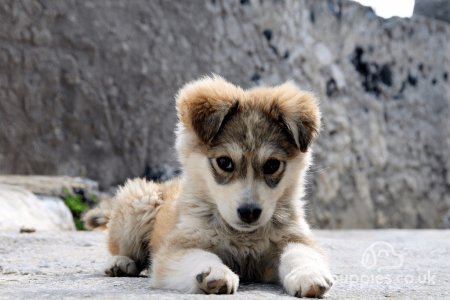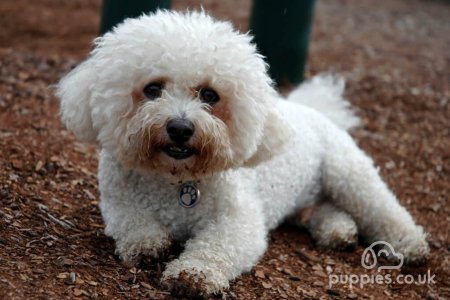Bergamasco (Bergamasco Shepherd, Cane da pastore Bergamasco)
Overview
An ancient breed resembling a mop (but with far more character!), the Bergamasco Shepherd is a pastoral breed that makes for a wonderful, loving companion pet at home or for pastoral use on a livestock farm.
This well-disciplined and dutiful breed has a loyal yet playful temperament, but most of us probably notice their shaggy appearance first and foremost. For owners that want a reliable, confident dog for their home, the Bergamasco will not disappoint.
Physical Appearance
Bergamascos are a medium to large-sized breed easily distinguished from most other breeds by their woolly, shaggy, and densely matted coats of fur adapted for the cooler alpine and subalpine climates of northern Italy.
As a pastoral breed, Bergamascos share many similarities with other sheepdogs and pastoral breeds such as the Hungarian Puli and Bearded Collie, which also have dense, woolly coats.
When standing, the Bergamasco exudes rustic strength and robustness, as well as confidence and alertness. Their forward-looking, chestnut coloured eyes belie a soft, gentle expression and their ears are set high at a semi-drop, lifting slightly when he is alert.
Coat colours include solid grey, often with grey patches. Colours such as isabella and light fawn are permitted, as is a completely black coat so long as it appears opaque.
How big do Bergamasco dogs get?
Character Traits
Vigilant yet relaxed, cautious yet warm to owners and their families, and intelligent yet challenging to train, Bergamasco Shepherds are quite typical of other pastoral breeds and as such may not be the best choice for first-time owners due to their strong temperament.
Best suited for agricultural and pastoral work on large, rural estates, they are ever vigilant thanks to their superb hearing and guard instincts. Although they are cautious around strangers, seldom will they show aggression to those they have entrusted.
Well-known for having a stubborn streak, Bergamascos are a challenge to train and socialise. Bergamascos, however, make for excellent natural watchdogs and guard dogs.
As an intelligent breed, Bergamascos tend to do as they please without any direction whilst working - they know their duties and perform them excellently.
Are Bergamasco dogs intelligent? Yes, very.
Are Bergamasco dogs affectionate? Yes.
Do Bergamasco dogs have high or low energy levels? Very high energy.
Are Bergamasco dogs loyal? Yes, but they can also be stubborn.
Are Bergamasco dogs playful? Yes.
Are Bergamasco dogs aggressive? No.
Are Bergamasco dogs easy to train? Not at all.
Are Bergamasco dogs good guard dogs? Yes, they are amongst the best watchdog and guard dog breeds.
Ability to Socialise
Socialising a Bergamasco Shepherd is extremely important, as with essentially all dog breeds. Nevertheless, they are a challenge to socialise and therefore should be introduced gradually to owners and their families so that they can form a strong, loyal bond with them as puppies and well into adulthood.
Bergamascos are stubborn, but they’re also intelligent. Although they may show signs of dominance with other pets, they are hardly ever aggressive. Aggression can be mitigated through excellent socialisation and training.
Around strangers, Bergamascos are cautious and do not trust easily. They are, after all, shepherd dogs bred to safeguard flocks of sheep and cattle in remote areas.
Due to their high intelligence and excellent traits, a well-socialised Bergamasco will grow into a loving companion well worth the effort put into training them.
Do Bergamasco dogs get along with other pets? Yes.
Do Bergamasco dogs get along with other dogs? Yes.
Are Bergamasco dogs good with kids? Yes, very.
Are Bergamasco dogs good with strangers? No, they tend to be cautious around strangers.
Lifestyle Suitability
This breed is not at all ideal for urban, apartment dwellings, nor is it ideal for owners looking for a calm and composed companion pet. Bergamascos thrive in rural environments with large, open pastures or fields whereby they can roam and claim as their own territory.
As a pastoral breed, Bergamascos need to be outdoors most of the day, only coming home to sleep or check up on their owners from time to time. Whilst at home, even in the dark of night their careful and cautious temperament leads them to patrol the home and protecting their loving owners.
Furthermore, they are a high-energy breed that requires plenty of exercise and stimulation. As puppies, they do love to play.
Are Bergamasco dogs good for first-time owners? Not at all.
Are Bergamasco dogs hypoallergenic? Not necessarily, as they shed very little.
Are Bergamasco dogs prone to drooling? Yes, somewhat.
Are Bergamasco dogs a good breed for apartment living? Absolutely not.
Do Bergamasco dogs shed a lot? A low amount of shedding.
Do Bergamasco dogs bark a lot? No, not much.
Can Bergamasco dogs be left alone at home? Yes, for moderate lengths of time.
Can Bergamasco dogs handle the heat? Yes, but not too hot.
Can Bergamasco dogs handle cold temperatures? Yes, they thrive in cold environments.
Are Bergamasco dogs sensitive to loud noises? Yes, as their hearing is top-notch.
General Health & Health Issues
As an ancient breed, Bergamascos have a superb track record of health and show very few hereditary health problems in general. Their rather long lifespan and excellent health make them an ideal choice for owners looking for a pure, healthy breed.
Nevertheless, routine visits to the veterinarian, much as your Bergamasco may not like them, are necessary for diagnosing any symptoms sooner rather than later so that appropriate treatment can be given.
Some common problems include:
Bloat: especially as they age, Bergamascos may experience bloat from an improper diet or an inconsistent feeding schedule. Speak with your veterinarian to develop an actionable plan to resolving bloat if it presents itself in your Bergamasco;
Joint dysplasia: common to many breeds, canine joint dysplasia, including hip dysplasia, is an instability of the hip joint, which can show symptoms such as a limp gait or lameness of the leg;
Skin allergies: atopic dermatitis, or skin allergies, are somewhat common to Bergamascos. Have them routinely inspected at the veterinarian clinic to diagnose the source of the allergy and to review possible treatment solutions.
How long do Bergamasco dogs live? - 13-15 years
Exercise & Play Time
Bergamascos are an energetic breed that requires plenty of exercise and outdoor playtime. Anywhere from around 1-2 hours per day are required, at a minimum, to keep your Bergamasco tired and thus happy.
As an intelligent breed, physical and mental stimulation is needed. It’s best to provide your Bergamasco with a large, open yard where he can run and play off lead safely.
When it comes to swimming, Bergamascos may or may not enjoy the water. As an owner, it is imperative that you maintain constant supervision simply due to their thick, woolly coats that can weigh the dog down and lead to difficulties swimming. Moreover, ensure that their coats are fully dried before entering the home again. It can take a long time to thoroughly dry their dense coats, and failure to do so can lead to skin irritation or bacteria forming deeper in the coat later on.
How much exercise does a Bergamasco dog need? - At least 1-2 hours per day
Do Bergamasco dogs like water play? It depends. They may love being in and around water, but they require constant supervision.
Nutrition & Feeding
On account of their large size and high energy levels, Bergamascos need a substantial amount of food to keep healthy. This can also be a problem, provided that they are not fed a high-quality diet and/or are fed at irregular feeding times throughout the day. Adjust feeding quantities for their age and weight carefully.
It is therefore essential that owners provide their Bergamasco with a high-quality diet rich in vitamins, nutrients, and minerals that promotes excellent health, in regular 3-4 feeding sessions per day. Raw diets or cold-pressed may be better than extruded (kibble), but discuss options with your veterinarian before pursuing any alternative diets.
Overeating or eating an improper diet may lead to bloat and possibly gastric torsion, so please endeavour to visit your veterinarian routinely to evaluate your feeding regimen for your Bergamasco.
Are Bergamasco dogs prone to weight gain? Yes, especially as they age.
How much should I feed a Bergamasco puppy? About 260-510g per day, in 3-4 sessions.
How much should I feed an adult Bergamasco dog? About 280-480g per day, in total.
Care & Maintenance
Although at first glance, grooming a Bergamasco may seem like an extremely challenging feat, most of the work comes through routine brushing and untangling their locks. The bad news is that this is itself quite time-consuming. The good news is that their coats contain plenty of natural oils to protect them whilst outdoors, so bathing is only really needed up to 3 times a year at most.
While most pastoral breeds can remain independent and even isolated for extended periods of time, Bergamascos do need some tender, loving, emotional care every so often. Please try not to neglect him and he’ll repay your affection and attention in kind.
- Grooming: as puppies, Bergamascos require little to no grooming as their signature coats haven’t grown in yet. After 12 months, groom and untangle their growing locks carefully as needed. As adults, groom them regularly and bathe 1-3 times per year.
- Emotional care: Bergamascos can tolerate some separation from their owners, but try not to let them feel neglected or lonely.
History of the Bergamasco
The name Bergamasco comes from the alpine Lombardy city in Italy of the same name, Bergamo. The breed is ancient in origin, possibly having been imported in pre-Roman antiquity by Phoenician traders to the Lombardy and Po Valley regions of northern Italy. If true, this would mean that the ancient ancestors of the Bergamasco were from today’s Lebanon or Levant region.
As it was in antiquity to modern times, the Bergamasco served as a loyal, dutiful pastoral dog tasked with guarding sheep and cattle in the subalpine and alpine climates of northern Italy.
Although an ancient breed, the Bergamasco was not formally recognised until 1891 when they were featured in the Italian Stud Book. They had received their own association in 1949, the Associazione Amatori del Cane da Pastore Bergamasco. Their numbers dwindled to dangerously low numbers during the Second World War but rebounded in the 1960s thanks to avid breeders in Italy. They are recognised by most international Kennel Clubs today, but their population remains relatively low.
Interesting Facts About Bergamasco Dogs
The Bergamasco may be as old as 7,000 years old, with origins in ancient Persia;
The thick, woolly coats of a Bergamasco take a long time to dry if wet, up to eight hours;
After 12 months of age, the Bergamasco’s coat undergoes a third ‘phase’ whereby maintenance needs are far lower than one may expect.
Getting a Bergamasco Puppy
Finding a Bergamasco near you may be a challenge. Not only are they quite a rare breed, but their popularity in the UK remains relatively low and thus there may not be many breeders around. Please consult our buying guide and if you’d like to purchase a Bergamasco, rest assured that our listed breeders are reputable and adhere to Kennel Club guidelines for puppy breeding.
How much does a Bergamasco cost to buy? - Around £700-£1,000.
How much does a Bergamasco cost to feed? - An adult Bergamasco costs about £1.80-£2.00 per day to feed.
How much does insurance for a Bergamasco cost? - About £30-£85 per month.
Sensible alternatives to purchasing a new Bergamasco puppy include rescue and adoption.
Additional resources can be found via Bergamasco registries and associations such as:











